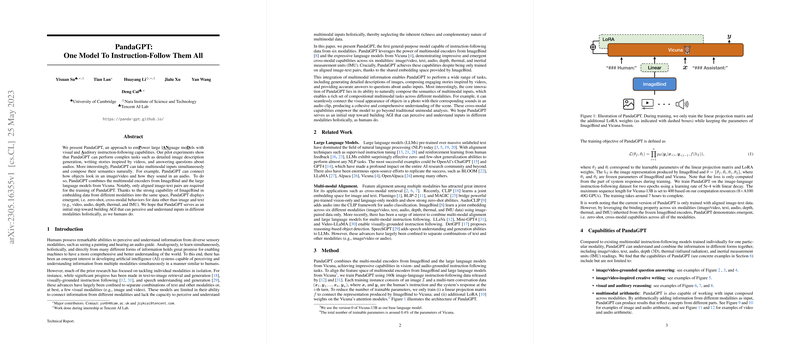Overview of PandaGPT: Integration of Multimodal Instruction-Following in LLMs
The paper presents PandaGPT, an advanced approach in AI for integrating multimodal capabilities into LLMs. PandaGPT extends the instruction-following capacities of these models by incorporating visual and auditory inputs, thereby enabling more comprehensive interaction with a diverse range of data sources. This integration is achieved primarily through the use of ImageBind's multimodal encoders combined with the language processing strength of the Vicuna model.
Technical Contributions
PandaGPT represents a significant advancement toward achieving holistic AI perception and understanding across varied sensory modalities, including text, image, video, audio, depth, thermal, and IMU data. The key innovation lies in its ability to perform cross-modal tasks without explicitly training on all possible combinations of modalities, thanks to ImageBind's shared embedding space.
- Multimodal Integration: By leveraging ImageBind’s embeddings, PandaGPT can handle and compose information from different modalities. This zero-shot cross-modal capability is crucial for tasks requiring simultaneous interpretation of visual and auditory data, such as generating image descriptions or responding to audiovisual prompts.
- Training Efficiency: The system is trained using aligned image-text pairs, minimizing the need for large datasets containing all possible modality combinations. The training involves only fine-tuning a linear projection and additional LoRA weights, leading to an efficient alignment process with limited computational resources.
Strong Numerical Results and Claims
The authors claim that PandaGPT demonstrates emergent behaviors across six modalities, despite being limited to image-text training data. The model exhibits capabilities such as image-grounded question answering, video-inspired creative storytelling, and complex multimodal arithmetic tasks, all underscoring its potential utility for various applications.
Implications and Future Directions
The development of PandaGPT offers several practical and theoretical implications. Practically, it sets the stage for more intuitive and human-like AI interactions, where systems can understand and respond to diverse and simultaneous sensory inputs. This has potential applications in areas like autonomous systems, virtual assistants, and augmented reality.
Theoretically, these advancements stress the importance of creating embeddings that can universally handle multiple data types, a key step toward general AI. However, the research acknowledges limitations, such as the current model’s reliance on aligned image-text pairs and its inability to generate multimodal outputs. Addressing these limitations could involve exploring fine-grained feature extraction and developing new benchmarks for evaluating multimodal understanding.
Future research might focus on the inclusion of more diverse alignment data across modalities and explore advanced attention mechanisms for deeper integration. Adjustments to allow PandaGPT to generate multimedia content could significantly enhance its application scope.
In conclusion, PandaGPT provides a promising framework for future AI systems that need to interact with the complexity of the world in a more integrative manner, embodying a significant step towards achieving general AI with multimodal input perception. The research opens avenues for further exploration in making AI systems that can truly mimic human-like understanding and perception.
